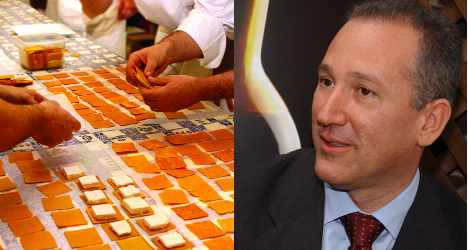Pasta with ketchup horrifies Italian foodies

If you've ever dolloped ketchup on your pasta or drunk a cappuccino with your pizza, you've likely offended an Italian. The Local speaks to Gianluigi Zenti, president of food culture organization Academia Barilla, about how foreigners can learn to eat like an Italian.
“When people ask, 'Where can I get pasta and ketchup?' we are horrified,” Zenti tells The Local.
“It has nothing to do with Italian cuisine.”
Pasta problems
Of the many sins committed by foreigners on holiday in Italy, or those who claim to love Italian cuisine from afar, Zenti says the main ones involve pasta.
Some Bolognese sauce with your spaghetti? A dash of oil to help the pasta cook? Think again. “Each of the 140 shapes of pasta in Italy goes with a specific sauce and comes from a specific region,” he says.
Spaghetti is from Naples, Zenti says, while Bolognese sauce is from Bologna. Someone putting the two together is geographically challenged to say the least.
Meanwhile, splashing oil into boiling water is a sign of poor quality pasta, which simply does not exist in Italy.
“In Italy, pasta can only be made with durum wheat - you go to jail if you use any other wheat,” Zenti says. The oil trick is used by foreigners who cook with poor quality pasta, made with different types of wheat which is only available abroad.
“Pasta was invented by the Romans and the Etruscans. There is a very established culture of how you cook it,” Zenti says with an air of pride.
Fake Italian food
What he terms “fake Italian recipes”, such as spaghetti Bolognese, are the fault of Italian émigrés.
“When they tried to open restaurants abroad they weren’t successful, so they adapted recipes to local tastes. Some spread the bad habits,” Zenti warns.
Thankfully, chefs in Italy are not willing to adapt their recipes to strange requests made by tourists.
According to Zenti there is no true Italian meal: “Everybody sees Italy as one country, but we have over 8,000 local authorities and each area has its own cuisine. We don’t have a national food.”
Coffee rules
Away from the restaurant, another temple of Italian gastronomy is the bar.
While pasta rules must be strictly adhered to, Zenti says baristas are more flexible when it comes to a visitor ordering a cappuccino at the ‘wrong’ time of day.
“After lunch or dinner they would never serve a cappuccino to a customer,” he says.
“But they are adaptable; they may be unhappy about doing it but they will. It’s more of a cultural than a nutritional issue.”
Such a regulated food culture may seem odd to outsiders, but Zenti says it is key to happiness.
“You don’t eat a sandwich in front of your computer...In Italy, you experience what you are eating and interact with people around you. It makes you happier.”
View the gallery of Academia Barilla's 10 Italian cooking commandments.
Comments
See Also
“When people ask, 'Where can I get pasta and ketchup?' we are horrified,” Zenti tells The Local.
“It has nothing to do with Italian cuisine.”
Pasta problems
Of the many sins committed by foreigners on holiday in Italy, or those who claim to love Italian cuisine from afar, Zenti says the main ones involve pasta.
Some Bolognese sauce with your spaghetti? A dash of oil to help the pasta cook? Think again. “Each of the 140 shapes of pasta in Italy goes with a specific sauce and comes from a specific region,” he says.
Spaghetti is from Naples, Zenti says, while Bolognese sauce is from Bologna. Someone putting the two together is geographically challenged to say the least.
Meanwhile, splashing oil into boiling water is a sign of poor quality pasta, which simply does not exist in Italy.
“In Italy, pasta can only be made with durum wheat - you go to jail if you use any other wheat,” Zenti says. The oil trick is used by foreigners who cook with poor quality pasta, made with different types of wheat which is only available abroad.
“Pasta was invented by the Romans and the Etruscans. There is a very established culture of how you cook it,” Zenti says with an air of pride.
Fake Italian food
What he terms “fake Italian recipes”, such as spaghetti Bolognese, are the fault of Italian émigrés.
“When they tried to open restaurants abroad they weren’t successful, so they adapted recipes to local tastes. Some spread the bad habits,” Zenti warns.
Thankfully, chefs in Italy are not willing to adapt their recipes to strange requests made by tourists.
According to Zenti there is no true Italian meal: “Everybody sees Italy as one country, but we have over 8,000 local authorities and each area has its own cuisine. We don’t have a national food.”
Coffee rules
Away from the restaurant, another temple of Italian gastronomy is the bar.
While pasta rules must be strictly adhered to, Zenti says baristas are more flexible when it comes to a visitor ordering a cappuccino at the ‘wrong’ time of day.
“After lunch or dinner they would never serve a cappuccino to a customer,” he says.
“But they are adaptable; they may be unhappy about doing it but they will. It’s more of a cultural than a nutritional issue.”
Such a regulated food culture may seem odd to outsiders, but Zenti says it is key to happiness.
“You don’t eat a sandwich in front of your computer...In Italy, you experience what you are eating and interact with people around you. It makes you happier.”
View the gallery of Academia Barilla's 10 Italian cooking commandments.
Join the conversation in our comments section below. Share your own views and experience and if you have a question or suggestion for our journalists then email us at [email protected].
Please keep comments civil, constructive and on topic – and make sure to read our terms of use before getting involved.
Please log in here to leave a comment.